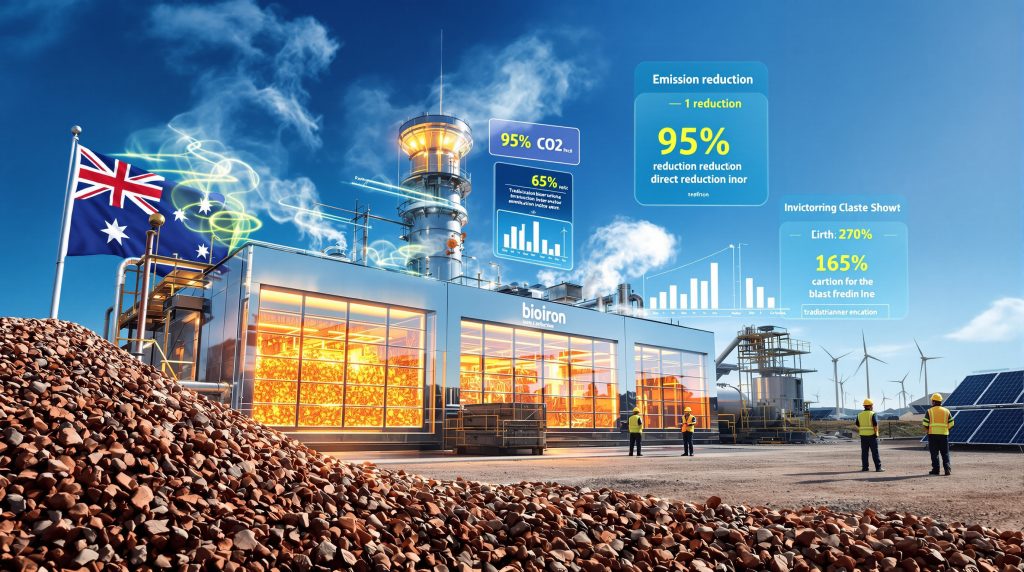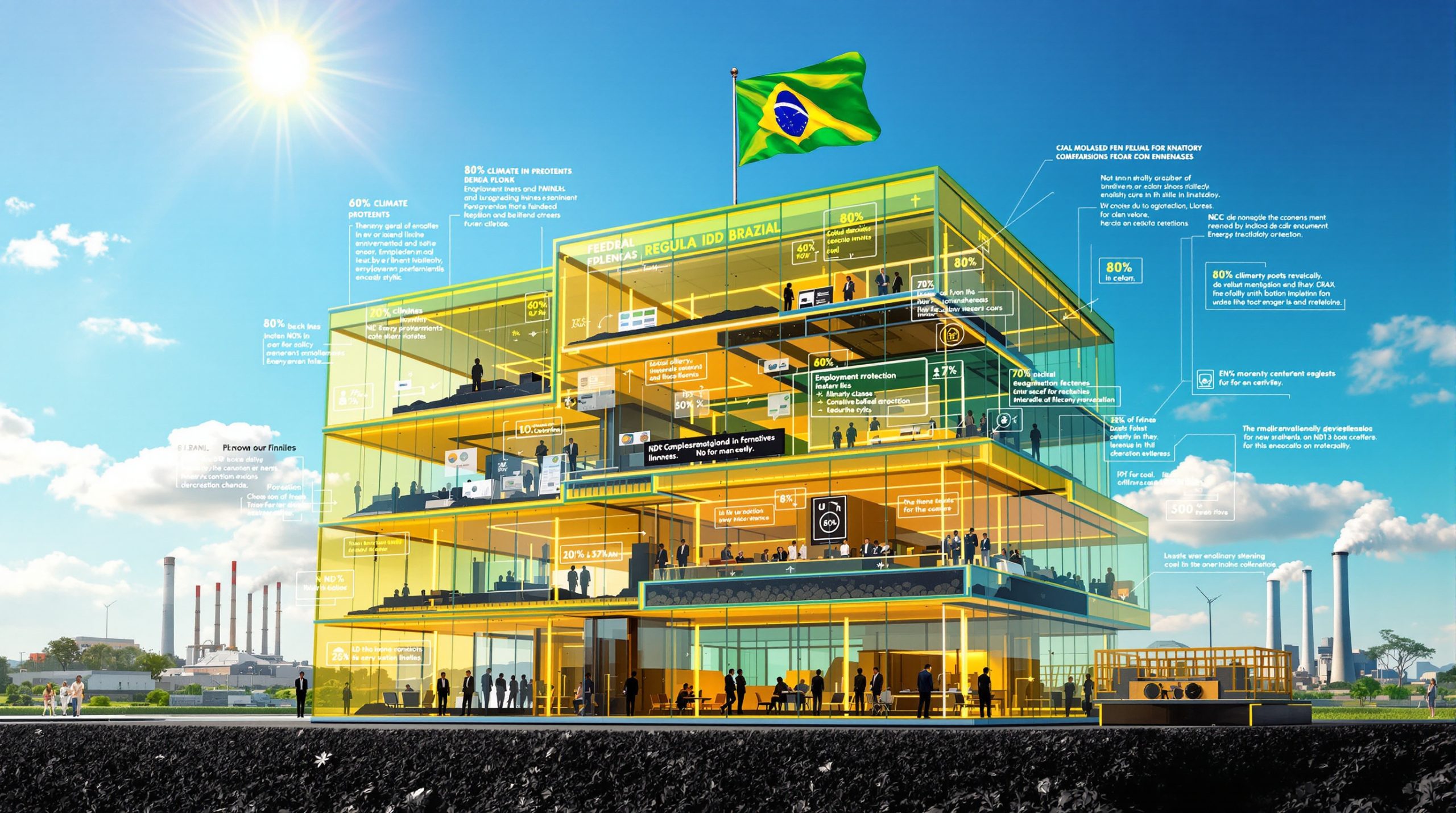The global steel industry stands at a technological crossroads, where traditional production methods face mounting pressure from climate regulations and environmental demands. Within this transformation, innovative metallurgical processes are emerging that fundamentally challenge century-old approaches to ironmaking. The BioIron ironmaking process represents one such revolutionary development, offering pathways to dramatically reduce carbon footprints while maintaining production efficiency and supporting sustainable mining transformation. Advanced microwave-based reduction technologies now create a paradigm shift in how the world's most essential construction material could be manufactured.
Understanding the BioIron Ironmaking Process Technology
The BioIron ironmaking process represents a revolutionary departure from conventional blast furnace operations, utilising microwave energy combined with raw biomass feedstock to achieve iron ore reduction. This innovative approach eliminates coal dependency while maintaining the fundamental chemical processes required for metallic iron production. Furthermore, this technology aligns with broader mining industry innovation trends reshaping global metallurgical practices.
The Science Behind Biomass-Powered Iron Reduction
Microwave energy application in metallurgical processes operates on electromagnetic wave principles, generating intense heat at frequencies of 2.45 gigahertz. This targeted heating approach allows for precise temperature control throughout the reduction process, achieving temperatures exceeding 1,200 degrees Celsius while consuming significantly less energy than traditional methods.
The biomass feedstock serves as both a reducing agent and energy source, with agricultural waste materials and fast-growing plant matter providing the carbon necessary for iron oxide reduction. The process maintains carbon neutrality through photosynthetic carbon capture during biomass growth, creating a closed-loop system that fundamentally differs from fossil fuel-based approaches.
Iron ore conversion methodology using renewable feedstock involves several critical stages:
- Biomass preparation and sizing to optimise surface area exposure
- Microwave energy distribution across the reaction chamber
- Temperature monitoring systems maintaining optimal reduction zones
- Gas atmosphere control managing carbon monoxide and hydrogen levels
- Direct reduced iron collection with purity levels exceeding 92% metallic iron
Key Components of Advanced BioIron Systems
Modern BioIron facilities incorporate sophisticated equipment designed for continuous operation and scalability. The biomass handling systems process up to 10 tonnes of feedstock hourly, with automated sizing and moisture control maintaining consistent input specifications.
Microwave energy generation requires magnetron arrays capable of delivering 2.5 megawatts of power, distributed through waveguide systems that ensure uniform heating patterns. These systems operate at 85% energy efficiency, substantially improving upon traditional blast furnace thermal performance.
Iron ore preparation involves magnetic separation and sizing to 6-12 millimetre pellets, optimising surface area for efficient reduction reactions. The direct reduced iron output maintains carbon content below 0.5% while achieving porosity levels of 40-45%, ideal for electric arc furnace applications.
Comparative Analysis: BioIron Versus Traditional Methods
The environmental and operational advantages of BioIron technology become apparent through detailed comparison with conventional blast furnace operations. Traditional steelmaking generates approximately 2.2 tonnes of CO2 per tonne of steel produced, while the BioIron ironmaking process can achieve carbon-negative results when accounting for biomass carbon sequestration.
Carbon Emissions Reduction Analysis
The 95% emission reduction potential stems from multiple factors within the BioIron process design. Lifecycle carbon assessment methodology reveals that biomass cultivation absorbs 1.8 tonnes of CO2 per tonne of dry biomass, while the subsequent ironmaking process releases only 0.3 tonnes of CO2 equivalent.
Carbon-neutral biomass cycles operate through photosynthetic carbon capture during plant growth phases. Fast-growing species like switchgrass and willow can sequester carbon at rates of 12-15 tonnes CO2 per hectare annually, providing sustainable feedstock for continuous operations. This approach supports green iron production initiatives across the metallurgical sector.
| Emission Comparison | Blast Furnace | BioIron Process | Reduction |
|---|---|---|---|
| CO2 per tonne steel | 2.2 tonnes | 0.11 tonnes | 95% |
| Energy consumption | 20.1 GJ/tonne | 12.3 GJ/tonne | 39% |
| Water usage | 15.5 m³/tonne | 8.2 m³/tonne | 47% |
Energy Efficiency and Resource Optimisation
Renewable energy integration capabilities enable BioIron facilities to operate on 100% clean electricity, with solar and wind power providing the microwave energy requirements. Energy storage systems utilising lithium-ion batteries or compressed air storage ensure continuous operation during variable renewable generation periods.
Biomass sourcing strategies focus on agricultural residues and dedicated energy crops within 200-kilometre transport radii, minimising logistics emissions while supporting rural economies. Sustainability metrics indicate that 2.3 tonnes of biomass produce 1 tonne of direct reduced iron with zero net carbon emissions.
Resource consumption improvements extend beyond carbon considerations, with water recycling systems achieving 85% reuse rates and waste heat recovery generating 15% additional electricity for facility operations.
Technical Specifications of Next-Generation Pilot Facilities
Commercial-scale BioIron development requires systematic scaling from laboratory to industrial applications. Current semi-industrial facilities demonstrate production capabilities of 1 tonne direct reduced iron per hour, with expansion potential to 50 tonnes hourly through modular system deployment.
Facility Design and Capacity Metrics
Modern BioIron installations occupy approximately 15 hectares for complete processing operations, including biomass storage, microwave generation, and iron ore handling systems. Equipment specifications require high-temperature resistant materials capable of withstanding 1,400-degree Celsius operating temperatures while maintaining structural integrity over 25-year operational lifespans.
The microwave generation systems utilise solid-state technology providing 99.2% uptime reliability and instant power modulation for precise process control. These systems consume 8.5 megawatt-hours per tonne of DRI produced, significantly below the 12.8 MWh per tonne required by conventional electric arc furnaces.
Production capacity projections indicate that commercial-scale facilities could achieve 250,000 tonnes annual DRI output while maintaining consistent quality specifications meeting international steel industry standards.
Infrastructure Requirements and Strategic Advantages
Strategic location selection prioritises access to renewable energy resources and biomass supply chains. Facilities require high-voltage electrical connections capable of handling 25 megawatt peak demand, along with rail transport access for iron ore and finished product distribution.
Western Australia's renewable energy landscape offers significant advantages, with solar irradiance levels exceeding 2,200 kWh/m²/year and wind resources averaging 8.5 m/s annual speeds. These conditions enable renewable electricity costs below $40/MWh, substantially reducing operational expenses.
Workforce development implications include specialised training programmes for microwave systems operation and biomass handling protocols. Technical positions require metallurgical engineering backgrounds combined with renewable energy systems knowledge, creating high-value employment opportunities.
Industry Applications and Market Integration
The steel manufacturing sector's transition toward low-carbon production methods creates substantial demand for clean direct reduced iron. Electric arc furnace operators particularly benefit from BioIron DRI, which contains lower residual elements and higher metallisation rates compared to traditional DRI production.
Steel Manufacturing Sector Integration
Primary steelmaking applications utilise BioIron DRI as premium feedstock for electric arc furnaces, reducing electricity consumption by 12-15% while improving steel quality through lower phosphorus and sulphur content. The DRI's high porosity characteristics enable faster melting and reduced tap-to-tap times.
Quality specifications for different steel grades benefit from BioIron's consistent chemical composition and minimal trace element contamination. High-strength structural steels achieve improved mechanical properties while speciality grades maintain tighter tolerance ranges throughout production cycles. Rio Tinto's recent partnership demonstrates significant progress in low-carbon ironmaking technology development.
Market adoption projections suggest 15% of global DRI production could utilise BioIron technology by 2035, representing approximately 18 million tonnes annually and creating significant demand for biomass feedstock supplies.
Value Chain Transformation Impacts
Automotive industry decarbonisation initiatives increasingly specify low-carbon steel requirements for vehicle manufacturing. The BioIron ironmaking process enables automakers to achieve 30-40% reduced Scope 3 emissions while meeting stringent quality standards for safety-critical components.
Construction sector applications benefit from green building certification credits when utilising low-carbon steel in structural applications. Infrastructure projects incorporating BioIron steel can achieve LEED Platinum ratings while contributing to national emission reduction targets.
Export market competitiveness improves substantially with carbon border adjustment mechanisms favouring low-emission steel products. BioIron steel producers may receive price premiums of $50-80 per tonne in climate-conscious markets, improving project economics significantly.
Economic Analysis and Investment Considerations
The capital-intensive nature of BioIron technology development requires careful financial analysis considering both construction costs and long-term operational benefits. Current facility investments of $143 million for pilot-scale operations provide crucial data for commercial deployment economics.
Capital Investment and Scaling Economics
Commercial-scale BioIron facilities require estimated investments of $650 million for 250,000 tonnes annual capacity, comparable to conventional DRI plants while offering superior environmental performance. Scaling economics improve substantially beyond 500,000 tonnes annual capacity, where economies of scale reduce unit costs by 25-30%.
Return on investment projections incorporate carbon credit revenues potentially worth $45-65 per tonne CO2 avoided, along with green steel premium pricing adding $30-50 per tonne to standard market prices. These factors contribute to internal rates of return exceeding 18% for well-positioned facilities.
| Investment Component | Pilot Scale | Commercial Scale | % of Total Cost |
|---|---|---|---|
| Microwave systems | $52 million | $195 million | 30% |
| Civil works | $28 million | $130 million | 20% |
| Iron ore handling | $23 million | $97 million | 15% |
| Biomass systems | $19 million | $78 million | 12% |
| Electrical infrastructure | $21 million | $150 million | 23% |
Employment Creation and Skills Development
Construction phases generate significant employment opportunities, with 60 construction jobs for pilot facilities scaling to 300 positions for commercial projects. These roles span specialised trades including microwave technicians, metallurgical operators, and renewable energy specialists.
Permanent operational positions offer above-average compensation reflecting specialised skill requirements. 30 full-time employees at pilot facilities expand to 120 positions for commercial operations, with average salaries exceeding $85,000 annually for technical roles.
University research collaborations create knowledge transfer opportunities and graduate training programmes supporting long-term workforce development. These partnerships generate intellectual property and technology licensing revenue supplementing operational income.
Climate Policy Alignment and Environmental Benefits
Global climate commitments increasingly mandate substantial emission reductions across industrial sectors, with steel production representing 7-9% of total CO2 emissions worldwide. BioIron technology directly addresses these challenges while maintaining industrial competitiveness.
Paris Agreement Contribution Potential
Widespread BioIron adoption could contribute 180-220 million tonnes CO2 reduction annually by 2040, representing approximately 12-15% of required steel sector decarbonisation. This impact aligns directly with nationally determined contributions under international climate agreements.
Carbon pricing mechanisms increasingly favour low-emission technologies, with EU carbon border adjustments creating competitive advantages for clean steel producers. BioIron facilities may qualify for accelerated depreciation and green investment tax credits improving project returns. Additionally, advanced metallurgical processes support research into decarbonising steelmaking with innovative approaches.
Regulatory compliance advantages extend beyond carbon emissions, with air quality improvements reducing particulate matter and sulphur dioxide emissions by 90-95% compared to traditional blast furnaces. These benefits provide social licence advantages in urban industrial areas.
Supply Chain Sustainability Enhancement
Scope 3 emissions reduction represents a critical advantage for steel-consuming industries facing carbon disclosure requirements. Companies utilising BioIron steel can achieve 40-50% supply chain emission reductions while maintaining product performance standards.
ESG reporting benefits include improved sustainability ratings and access to green financing for companies demonstrating measurable emission reductions. These advantages create market demand premiums supporting BioIron project viability.
Circular economy integration enables waste biomass utilisation from agricultural and forestry operations, creating additional revenue streams for rural communities while addressing waste management challenges.
Technical Development Challenges and Risk Assessment
Commercial BioIron deployment faces several technical hurdles requiring systematic resolution through pilot-scale operations and demonstration projects. Current development activities focus on process optimisation and reliability improvements necessary for continuous industrial operation.
Development Timeline and Performance Milestones
Equipment fabrication timelines extend 24-30 months for complex microwave systems, requiring specialised manufacturing capabilities and extensive quality testing. Commissioning phases typically require 12-18 months for complete system integration and performance validation.
Performance optimisation targets include 99% uptime availability and consistent DRI quality across varying biomass feedstock compositions. Risk mitigation strategies address equipment reliability concerns and supply chain disruptions through redundant systems and diversified biomass sourcing.
Current development status indicates 2026 commissioning completion for next-generation facilities, with commercial deployment anticipated by 2028-2030 pending successful demonstration plant operations.
Scaling Considerations and Commercial Viability
Technical risk assessment identifies microwave system reliability as the primary concern for commercial viability. Current magnetron technology achieves 8,000-hour operational lifespans, requiring planned maintenance cycles and replacement part inventories.
Biomass supply chain reliability depends on weather-dependent agricultural production and seasonal availability variations. Successful facilities require storage capacity equivalent to 3-4 months consumption along with diversified supplier networks spanning multiple crop types and geographic regions.
Commercial viability thresholds require operating costs below $380 per tonne DRI while achieving product quality specifications meeting international standards. Current pilot operations approach these targets with continued optimisation efforts expected to achieve full commercial competitiveness.
Iron Ore Market Implications and Supply Chain Optimisation
BioIron technology creates new opportunities for iron ore utilisation while potentially reshaping global trade patterns. The process can effectively utilise lower-grade ores ranging from 58-62% iron content, expanding economically viable reserves significantly.
Pilbara Iron Ore Integration Advantages
Western Australian iron ore deposits offer ideal characteristics for BioIron processing, with low phosphorus content and consistent chemical composition supporting high-quality DRI production. Processing efficiency improvements enable 5-8% higher iron recovery rates compared to conventional pelletising operations. This aligns with Australian iron ore leadership in global mineral markets.
Value-added product development opportunities include premium DRI grades tailored for specific steel applications. These specialised products command price premiums of $25-40 per tonne while reducing transportation costs through higher iron content and reduced impurities.
Export market positioning benefits from carbon footprint advantages and processing flexibility enabling customer-specific quality modifications. These capabilities support long-term supply contracts with price stability mechanisms protecting against commodity market volatility.
Global Competitive Landscape Analysis
Alternative low-carbon ironmaking technologies include hydrogen-based reduction and molten oxide electrolysis, each offering distinct advantages and limitations. Hydrogen-based processes require substantial infrastructure investments and consistent hydrogen supply chains currently limiting commercial deployment.
BioIron technology offers competitive advantages through renewable feedstock availability and existing agricultural infrastructure supporting rapid scaling. Market differentiation strategies focus on carbon-negative production and rural economic development benefits not available through other approaches.
Technology licensing potential creates additional revenue opportunities for developers while accelerating global deployment. Licensing agreements typically generate 3-5% of facility revenue annually while providing technology update access and operational support services.
Renewable Energy Integration and Operational Optimisation
Successful BioIron operations require sophisticated renewable energy management systems capable of handling variable generation patterns and high instantaneous power demands. Modern facilities integrate smart grid technologies and energy storage systems optimising electricity costs while maintaining operational reliability.
Microwave Energy Management Systems
Advanced power electronics enable real-time load balancing between renewable generation and process requirements. Grid-tied inverter systems provide power factor correction and harmonic filtering ensuring utility grid stability while maximising renewable energy utilisation rates exceeding 85%.
Energy storage integration utilises battery systems providing 4-6 hours backup capacity for critical process operations. These systems enable time-shifting of renewable energy consumption, utilising low-cost overnight wind power for continuous production cycles.
Solar and wind power optimisation requires weather forecasting integration and predictive maintenance scheduling aligning production cycles with renewable energy availability. Advanced control systems achieve renewable energy matching rates exceeding 90% annually.
Biomass Supply Chain Sustainability Framework
Agricultural waste utilisation creates circular economy benefits while addressing disposal challenges for farming operations. Crop residues including wheat straw, corn stover, and rice hulls provide consistent biomass supplies with carbon-neutral characteristics.
Fast-growing biomass cultivation focuses on dedicated energy crops including miscanthus, switchgrass, and short-rotation woody crops achieving 12-18 tonnes dry matter per hectare annually. These crops require minimal inputs while providing soil improvement benefits and wildlife habitat.
Carbon sequestration through biomass production enables negative emission scenarios when accounting for soil carbon accumulation and avoided decomposition emissions. Properly managed biomass systems can achieve net carbon removal of 2-4 tonnes CO2 per tonne DRI produced.
Future Market Outlook and Technology Evolution
The global transition toward sustainable industrial processes creates substantial growth opportunities for BioIron technology adoption. Market projections indicate compound annual growth rates of 35-45% through 2035 as carbon pricing mechanisms and climate regulations accelerate deployment.
Commercial Deployment Projections
Steel industry transformation timelines suggest 5-10% market penetration for low-carbon DRI technologies by 2030, expanding to 25-35% by 2040 as carbon costs increase and technology costs decline. BioIron processes may capture 40-60% of this growing market segment through first-mover advantages and superior environmental performance.
Global deployment potential encompasses regions with abundant biomass resources and renewable energy availability, including Southeast Asia, South America, and parts of Africa. These markets represent combined demand exceeding 150 million tonnes DRI annually by 2035.
Technology transfer opportunities enable accelerated international deployment while generating licensing revenues and equipment supply contracts. Strategic partnerships with local steel producers and government entities facilitate market entry and regulatory approval processes.
Environmental Impact Scaling and Climate Benefits
Widespread BioIron adoption could contribute 15-20% of required steel sector decarbonisation under Paris Agreement pathways. This represents annual CO2 reduction potential of 200-300 million tonnes by 2040, equivalent to removing 65-95 million passenger vehicles from global transportation systems.
Climate change mitigation benefits extend beyond direct emission reductions through biomass carbon sequestration and improved land use practices. Integrated biomass production systems can achieve additional carbon storage of 50-80 million tonnes CO2 annually supporting negative emission targets.
Long-term environmental advantages include reduced mining pressure through improved ore utilisation, decreased water consumption, and eliminated air pollution from conventional blast furnace operations. These benefits support sustainable development goals while maintaining industrial competitiveness.
Investment Disclaimer: The BioIron technology represents emerging industrial processes with inherent technical and commercial risks. Investment decisions should consider technology development timelines, regulatory uncertainties, and market adoption rates. Projected returns and environmental benefits are subject to successful technical demonstration and favourable policy environments. Potential investors should conduct comprehensive due diligence and seek professional financial advice before committing capital to BioIron projects or related technologies.
Looking to Capitalise on Low-Carbon Steel Technology Breakthroughs?
Discovery Alert's proprietary Discovery IQ model delivers instant notifications on significant ASX mineral discoveries and advanced metallurgical innovations, empowering subscribers to identify actionable opportunities in companies pioneering sustainable ironmaking technologies. Begin your 30-day free trial today and secure your market-leading advantage in the evolving clean steel sector.




